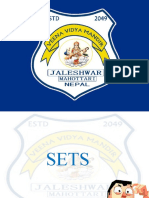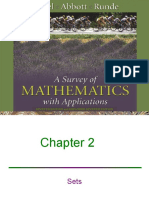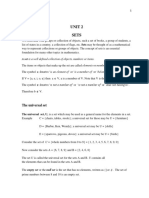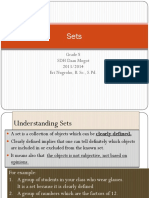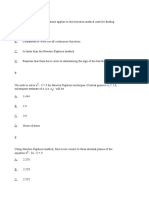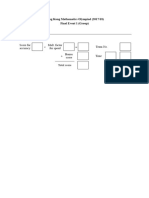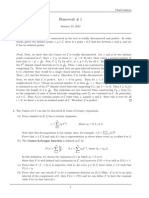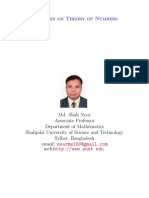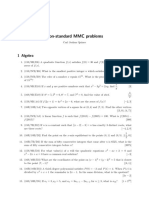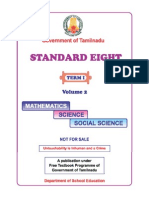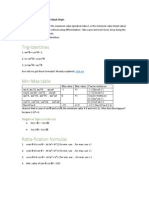1
2.0 SETS
Sabih Siddiqui 0313-2344852
Introduction
When you observe the kitchen, you will likely find that related objects are kept together. Plates are kept
together, as well as pots and spoons. As they found together, we can collectively call them; a set of plates, a
set of pots and a set of spoons. These sets are then put in the same or different compartments.
We use sets in our everyday lives. Whenever we group similar things together, we are applying sets in real
life. So, what is a set? A set is a collection of well defined objects. In this unit, you will learn about the types
�� �
of sets, how to describe a set and many more.
2
Specific outcomes
By the end of this unit, you will be able to:
❖ Define a set
❖ Represent a set in the following ways:
• Descriptive form
• Tabular form
• Set builder notation
❖ Describe the following types of sets:
• Empty set
• Singleton set
• Finite set
• Infinite set
H
❖ Represent the following sets in a Venn diagram:
1
• Subset
• Complement of a set
• Union of sets
• Intersection of sets
1
iddiq U 238 126
I
I
I
92 53
Sets
� 2
SETS
2.1 SETS
Sabih Siddiqui 0313-2344852
• A set is a collection of well-defined objects.
• Objects in a set are called elements or members of a set.
• Elements can be anything, for example, numbers, letters, words or people.
• Sets are denoted by capital letters.
• Members or elements can be represented by numbers, lowercase letters or words.
• Elements are separated by commas and enclosed in curly brackets.
• For example:
A = {1, 2, 3, 4}; a set of natural numbers
C = {red, yellow, blue, white}; a set of colours
V = {𝑎, 𝑒, 𝑖, 𝑜, 𝑢}; a set of vowels
�� �
2
2.2 REPRESENTATION OF SETS
• A set can be represented in various forms.
• The commonest ways of representing sets are descriptive form, tabular form and set builder
notation.
1. DESCRIPTIVE FORM
• In descriptive form, a set is defined by describing the contents of a set.
• For example:
A = a set of first five natural numbers
C = a set colours of the rainbow
V = a set of vowels
2. TABULAR FORM
• In tabular form (also called roster form), elements are listed separated by commas and enclosed
in curly brackets.
H
• For example: 1
A = {1, 2, 3, 4, 5}
C = {red, orange, yellow, green, blue, indigo, violet}
V = {𝑎, 𝑒, 𝑖, 𝑜, 𝑢}
3. SET BUILDER NOTATION
1
iddiq U
• In set builder notation, the common property of the elements is specified.
• The notation is written in the form of:
I
A = {𝑥 | common property that defines 𝑥} 238 126
I
read as “set A is a set of all x’s such that x…”
• For example:
A = {𝑥 | 𝑥 is a natural number less or equal to 5}
read as “set A is a set of all x’s such that x is a natural
92 number less than 53
or equal to 5”
I
this can also be written as A = {𝑥 ∈ ℕ| 𝑥 ≤ 5}
C = {𝑥 | 𝑥 is a colour of a rainbow}
V = {𝑥 | 𝑥 is a vowel}
Sets
� 3
2.3 ELEMENTS OF A SET
Sabih Siddiqui 0313-2344852
• The symbol ∈ means “is an element of” or “is a member of”.
• For example, given that set N = {1, 2, 3, 4, 5}.
2 ∈ N, read as “2 is an element of set N”
5 ∈ N, read as “5 is an element of set N”
• The symbol ∉ means “is not an element of” or “is not a member of”.
• Given that set N = {1, 2, 3, 4, 5}.
0 ∉ N, read as “0 is not an element of set N”.
8 ∉ N, read as “8 is not an element of set N”.
• n(A) indicates the number of elements in set A. For example, given that:
N = {1, 2, 3, 4, 5}, then n(N) = 5, meaning that set N has 5 elements
P = {0, 1}, then n(P) = 2, meaning that set P has 2 elements
�� �
2
2.4 TYPES OF SETS
1. EMPTY SET
• An empty set is a set that does not contain any element.
• It is also called a null set.
• It is denoted by ∅ or { }.
A={}
2. SINGLETON SET
• A singleton set is a set that contains only one element.
• For example:
B = {4}
P = { 2}
R = {20}
• Each of the sets above is a singleton set. Each set contains only one element.
H
1
3. FINITE SET
• A finite set is a set that contains a countable number of elements.
• For example:
1 that is, five elements.
N = {1, 2, 3, 4, 5}; set N has a countable number of elements,
iddiq U
D = {days of the week}; set D has a countable number of elements. A week has seven days.
I
4. INFINITE SET 238 126
I
• An infinite set is a set that contains an uncountable number of elements.
• For example:
A = {… , 2, 1, 0, 1, 2, … }; set A is the set of all integers. Integers are uncountable.
I
The three dots (…) means “continue on”. 92 53
P = {𝑥 | 𝑥 is a prime number greater than 2}; set P is a set of prime numbers.
Prime numbers above 2 are uncountable.
Sets
� 4
2.5 UNIVERSAL SET AND SUBSETS
Sabih Siddiqui 0313-2344852
❖ UNIVERSAL SET
• A universal set is a set that contains all elements under consideration.
• It is denoted by U, and sometimes by 𝜉.
• If A and B are two sets, such that set A = {1, 3, 5, 7, 9} and set B = {2, 4, 6, 8, 10}, then the
universal set of set A and set B is U = {1, 2, 3, 4, 5, 6, 7, 8, 9, 10}.
❖ SUBSETS
• A subset is a set in which all its elements are members of another set.
• It is denoted by ⊆, read as “is a subset of”.
• Set A is a subset of set B if all the elements of set A are members of set B.
�� �
A⊆B
2
• For example, if set Q = {1, 2, 3, 4, 5} and set P = {2, 4} then set P is a subset of set Q, as all the
elements of set P are also elements of set Q. This is written as shown:
P ⊆ Q read as “set P is a subset of set Q”.
• Set A can be equal to set B. However, if set A is not equal to set B then set A is a proper subset
of set B.
• A proper subset is a set in which all its elements are also members of another set but the other
set contains elements it does not contain.
• In the example above, set P is a proper set of set Q. All elements of set P are also members of
set Q, but set Q contain members such as 1, 3 and 5, that are not members of set P. Proper subset
is denoted by ⊂.
• The set itself and the empty set are always subsets.
• If a set contains at least one element that is not in the other set then the set is not a subset.
• For example, if set C = {2, 4, 6} and D = {1, 2, 3, 4, 5}, set C is not a subset of set D. Set C has an
element, element 6 that is not a member of set D.
• The symbol ⊈ is used to indicate “not subset of”. Then C ⊈ D, and it is read “set C is not a
H
subset of set D”. 1
❖ EXAMPLES
1. Write down the universal set of the following sets.
1
A. J = {1, 2, 3} and K = {2, 4}
iddiq U
B. L = {2, 5, 7, 9, 11, 13} and M = {2, 5, 7, 11}
C. N = {2, 4, 6, 8} and O = {2, 4, 6, 8}
I
D. P = { 1, 4, 3, 0, 1, 2, 5,6} and Q = {0, 3, 1, 7} 238 126
I
2. Indicate the relationship of each of the pair of set has a subset of, proper subset of or not
subset of.
A. J = {1, 2, 3} and K = {2, 4}
I
92 53
B. L = {2, 5, 7, 9, 11, 13} and M = {2, 5, 7, 11}
C. N = {2, 4, 6, 8} and O = {2, 4, 6, 8}
D. P = {6, 1, 4, 3, 0, 1, 2, 5} and Q = {0, 3, 1, 7}
Sets
� 5
❖ SOLUTIONS
Sabih Siddiqui 0313-2344852
1. A. U = {1, 2, 3, 4}
B. U = {2, 5. 7, 9, 11, 13}
C. U = {2, 4, 6, 8}
D. U = { 1, 0, 1, 2, 3, 4, 5, 6, 7}
2. A. K ⊈ J (K is a proper subset of J)
B. M ⊂ L (M is a proper subset of L)
C. O ⊆ N (O is a subset of N)
D. Q ⊈ P (Q is not a subset of P)
�� �
2.6 VENN DIAGRAM
• A Venn diagram shows the relationship of sets in the form2 of a diagram.
• It consists of a rectangle and circles within it.
• The triangle represents the universal set and is usually indicated by the symbol 𝜉.
• The circles within the triangle indicate subsets.
• In the Venn diagram above, the universal set 𝜉 = {1, 2, 3, 4, 5, 6, 7, 8, 9, 10}. Set A = {1, 2} and
set B = {3, 4, 5}. Elements that are not in set A and set B but are members of the universal set are
H
placed outside the circles but inside the triangle.
1
❖ SUBSETS
• To represent a subset in a Venn diagram, a subset is placed inside another circle.
1
The shaded region shows B ⊆ A
iddiq U 238 126
I
I
I
• Example, given that 𝜉 = {1, 2, 3, 4, 5, 6, 7, 8, 9, 10}. Set A = {1, 2,923, 4, 5, 6} and set B 53
= {1, 2, 3}.
Show the sets in a Venn diagram.
7 to 10 elements are placed outside both
circles but inside the rectangle. They are
not members of set A and B, but are
members of 𝜉.
Sets
� 6
❖ COMPLEMENT OF A SET
Sabih Siddiqui 0313-2344852
• The complement of set A is a set of all elements in the universal set that are not in set A
• It is denoted by A'.
The shaded region shows A'
�� �
• Example, given that 𝜉 = {1, 2, 3, 4, 5, 6, 7, 8, 9, 10} and set A = {1, 2, 3, 4}. Show the sets in a Venn
diagram and find A'. 2
𝜉 = {1, 2, 3, 4, 5, 6, 7, 8, 9, 10}
A = {1, 2, 3, 4}
A' = {5, 6, 7, 8, 9, 10}
❖ UNION OF SETS
• A union of sets is a set formed by combining all elements of the given sets.
• It is denoted by ∪.
• Union of two sets A and B is obtaining by combining all elements of set A and set B, and it is
H
denoted by A ∪ B. 1
The shaded region shows A ∪ B
iddiq U 238 126
I
I
• Example, given that 𝜉 = {1, 2, 3, 4, 5, 6, 7, 8, 9, 10} and set A = {2, 3, 4, 5, 6} and B = {5, 6, 7, 8}.
Show the sets in a Venn diagram and find A ∪ B.
I
92 53
A ∪ B = {2, 3, 4, 5, 6, 7, 8}
Sets
� 7
❖ INTERSECTION OF SETS
Sabih Siddiqui 0313-2344852
• The intersection of sets is a set of common elements which belong to the given sets.
• It is denoted by ∩.
The shaded region shows A ∩ B
�� �
• Example, given that 𝜉 = {1, 2, 3, 4, 5, 6, 7, 8, 9, 10} and set A = {2, 3, 4, 5, 6} and B = {5, 6, 7, 8}.
Show the sets in a Venn diagram and find A ∩ B. 2
A ∩ B = {5, 6}
❖ EXAMPLES
1. Name the shaded region for the Venn diagram.
H
A. B. 1
iddiq U 238 126
I
I
C. D.
I
92 53
Sets
� 8
2. Name the region defined by the following shading.
Sabih Siddiqui 0313-2344852
A. B.
C. D.
�� �
2
E. F.
3. Given the following Venn diagrams
H
1
iddiq U 238 126
I
I
Diagram 1 Diagram 2
I
92 53
Diagram 3 Diagram 4
Sets
� 9
Sabih Siddiqui 0313-2344852
Diagram 5 Diagram 6
�� �
Match the following description with the diagrams above
A. P ∩ Q 2
B. (P ∪ Q) ∩ R'
C. P ∩ Q ∩ R
D. Q ∩ (P ∪ R)'
E. Q ∩ R ∩ P'
F. Q ∪ R
❖ SOLUTIONS
1. A. A
B. A'
C. A ∪ B
D. A ∩ B
2. A. (A ∪ B)' or A' ∩ B'
H
B. (A ∩ B)' or A' ∪ B' 1
C. A ∩ B'
D. A ∪ B' or (A' ∩ B)'
E. (A' ∩ B') ∪ (A ∩ B)
F. (A ∩ B') ∪ (A' ∩ B) 1
iddiq U
3. A. Diagram 5
B. Diagram 4
I
C. Diagram 1 238 126
I
D. Diagram 6
E. Diagram 2
F. Diagram 3
I
92 53
Sets




